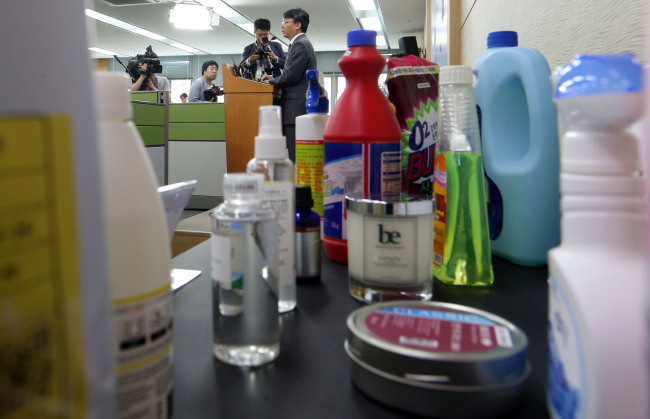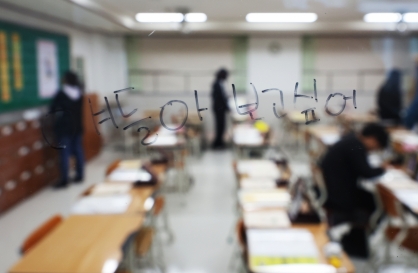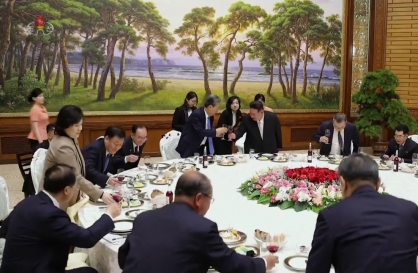Ministry bans sales of seven toxic household products
By Kim Da-solPublished : May 17, 2016 - 16:50
The Environment Ministry announced Tuesday it will ban sales of seven household products that were found to contain toxic ingredients -- including those that were used in humidifier disinfectants -- and breached chemical content levels.
The ministry said it has inspected a total of 331 products that have been distributed in the market since the second half of last year on their chemical safety. Seven of them were found to contain banned substances or exceed the permitted amount based on the Chemicals Registration and Assessment Act implemented in January 2015.
They include a leather-cleaning detergent (sold as Leather CLEAN & RENEW WIPES), a furniture detergent (FURNITURE CREAM), a drain cleaner (MELT), a tattoo dye (NANO Dark Brown), shoes freshener (Biopitone’s Shoes Antiseptic), fabric freshener (Awesome FABRIC) and an air conditioner freshener (Air conditioner and Heater Sterilizer).
The ministry said it has inspected a total of 331 products that have been distributed in the market since the second half of last year on their chemical safety. Seven of them were found to contain banned substances or exceed the permitted amount based on the Chemicals Registration and Assessment Act implemented in January 2015.
They include a leather-cleaning detergent (sold as Leather CLEAN & RENEW WIPES), a furniture detergent (FURNITURE CREAM), a drain cleaner (MELT), a tattoo dye (NANO Dark Brown), shoes freshener (Biopitone’s Shoes Antiseptic), fabric freshener (Awesome FABRIC) and an air conditioner freshener (Air conditioner and Heater Sterilizer).

These products either used forbidden toxicoid such as PHMG and PHMB or contained chemicals up to 40 times more than the allowed content level. The ministry ordered immediate recall of all of these products.
Current law states that the ministry is responsible for overseeing the safety of 15 new types of household products that include detergent, bleach, fabric conditioner, coating agent, air freshener, preservative, insecticide, antiseptic, tattoo dye, coloring bleach, antifogging agent and antirust additives. Most of these products were handled as industrial products until the law was enacted. For official sales, chemicals contained in these products must meet the content standard set by the ministry.
The ministry also looked into 15,496 products that are sold in large volumes or are spray-type items that can pose higher health risk for users. It said 61 of them have been ordered to correct their product labeling for a more accurate list of contents or to attach material information. One company, which was found to have faked its Korea Certification authentication number, was called to voluntarily recall items.
Despite the enforcement of the new law that expanded the scope of the Environment Ministry’s watch on household items, questions remain over the efficacy as the safety certification system remains the same.
Makers and distributors of Household chemical products are required to self-test their products for chemical safety and receive KC mark from the government. The self-inspection standards and criteria vary for chemicals and items. Such a system has been compared to other countries such as the United States where all products are tested at a third-party research organization prior to sales.
“In order to strengthen the chemical regulation, the ministry will require products approved with KC mark to be retested for chemical safety every three years,” said an official from the Environment Ministry.
It added that both the environment and industry ministries will continue to monitor and inspect a wider range of products.
Also on Tuesday, the ministry said it has reviewed the list of ingredients contained in Procter & Gamble’s air freshener Febreze.
“So far, the air freshener’s usage form or frequency (of questionable ingredient) does not seem to be health-threatening such as by causing immediate respiratory system damage,” said professor Yang Ji-yeon of the institute for Environmental Research at the press briefing.
The company’s local unit P&G Korea had faced suspicions that its product contains toxic substances that could harm lungs when inhaled.
Among the disputed substances, 0.01 percent of BIT used as preservative and 0.14 percent of DDAC used in detergent was detected from the product.
“The toxicity risk of BIT is very low while toxicity test for DDAC should be redone as there is no concrete safety standard for this substance,” Yang said.
The upper ceiling for DDAC in Febreze sold in the U.S. is 0.33 percent, more than the double the content included in local Febreze products.
After submitting the related list to the ministry, P&G Korea said that it is also considering to make the list of substances public. The firm emphasized that “DDAC is a safe chemical allowed in Korea and other advanced countries as well.”
By Kim Da-sol (ddd@heraldcorp.com)
Current law states that the ministry is responsible for overseeing the safety of 15 new types of household products that include detergent, bleach, fabric conditioner, coating agent, air freshener, preservative, insecticide, antiseptic, tattoo dye, coloring bleach, antifogging agent and antirust additives. Most of these products were handled as industrial products until the law was enacted. For official sales, chemicals contained in these products must meet the content standard set by the ministry.
The ministry also looked into 15,496 products that are sold in large volumes or are spray-type items that can pose higher health risk for users. It said 61 of them have been ordered to correct their product labeling for a more accurate list of contents or to attach material information. One company, which was found to have faked its Korea Certification authentication number, was called to voluntarily recall items.
Despite the enforcement of the new law that expanded the scope of the Environment Ministry’s watch on household items, questions remain over the efficacy as the safety certification system remains the same.
Makers and distributors of Household chemical products are required to self-test their products for chemical safety and receive KC mark from the government. The self-inspection standards and criteria vary for chemicals and items. Such a system has been compared to other countries such as the United States where all products are tested at a third-party research organization prior to sales.
“In order to strengthen the chemical regulation, the ministry will require products approved with KC mark to be retested for chemical safety every three years,” said an official from the Environment Ministry.
It added that both the environment and industry ministries will continue to monitor and inspect a wider range of products.
Also on Tuesday, the ministry said it has reviewed the list of ingredients contained in Procter & Gamble’s air freshener Febreze.
“So far, the air freshener’s usage form or frequency (of questionable ingredient) does not seem to be health-threatening such as by causing immediate respiratory system damage,” said professor Yang Ji-yeon of the institute for Environmental Research at the press briefing.
The company’s local unit P&G Korea had faced suspicions that its product contains toxic substances that could harm lungs when inhaled.
Among the disputed substances, 0.01 percent of BIT used as preservative and 0.14 percent of DDAC used in detergent was detected from the product.
“The toxicity risk of BIT is very low while toxicity test for DDAC should be redone as there is no concrete safety standard for this substance,” Yang said.
The upper ceiling for DDAC in Febreze sold in the U.S. is 0.33 percent, more than the double the content included in local Febreze products.
After submitting the related list to the ministry, P&G Korea said that it is also considering to make the list of substances public. The firm emphasized that “DDAC is a safe chemical allowed in Korea and other advanced countries as well.”
By Kim Da-sol (ddd@heraldcorp.com)




















